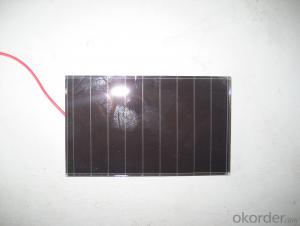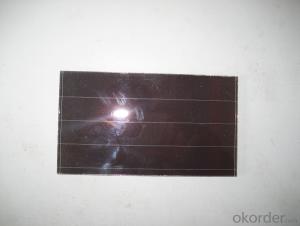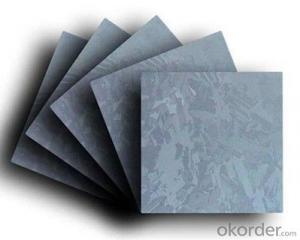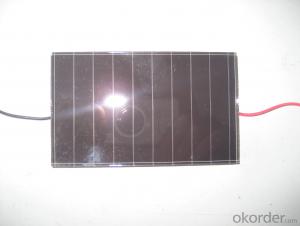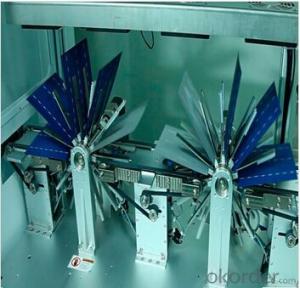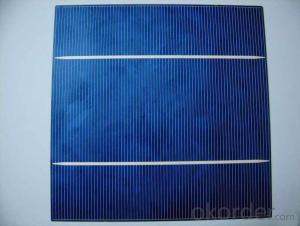Amorphous silicon dice specification 2
- Loading Port:
- China Main Port
- Payment Terms:
- TT OR LC
- Min Order Qty:
- -
- Supply Capability:
- -
OKorder Service Pledge
OKorder Financial Service
You Might Also Like
Pv modules at present, the mainstream products are still in silicon as the main raw materials, only in terms of silicon raw material consumption, production 1 mw of crystalline silicon solar cell, need 10 to 12 tons of high purity silicon, but if use the same silicon materials used to produce thin film amorphous silicon solar cell can produce more than 200 mw.
From the perspective of energy consumption, amorphous silicon solar battery only 1-1.5 years of energy recovery period, more embodies its contribution to energy saving in the manufacturing process.
Component occupies a high proportion of costs in a photovoltaic system, the component prices directly affect the system cost, and thus affect the cost of photovoltaic power generation. Calculated at the current price of components, the same money, buy amorphous silicon products, you can get more close to 30% of the power components.
2, more power
For the same power of solar cell array, amorphous silicon solar cell is about 10% more than monocrystalline silicon, polycrystalline silicon battery power. This has been the Uni - Solar System LLC, Energy Photovoltaic Corp., Japan's Kaneka Corp., the Netherlands Energy research institute, and other organizations and experts confirmed that the Photovoltaic industry.
In sunny, that is to say, under the high temperature, amorphous silicon solar cell components can show more excellent power performance.
3, better low light response
Due to the characteristics of amorphous silicon atoms are arranged disorderly, the electron transition no longer comply with the restriction of traditional \"selection rule\", as a result, its light absorption characteristics and there are big differences monocrystalline silicon material. Amorphous silicon and monocrystalline silicon material absorption curve as shown
, amorphous silicon absorption curve has obvious three sections (A, B, C). Area A corresponding electronic transition between localized states, such as the gap state near Fermi level and to the tail state transition, the absorption coefficient is small, about 1-10 cm - 1, for this is absorbing; B area absorption coefficient with the increase of the photon energy index rose, it corresponds to the electrons from the valence band edge extension state to the conduction band localized state transition, as well as the localized electrons from the valence band tail states guide for edge extension state transition, the region's energy range is usually only about half of the electron volts, but absorption coefficient across two or three orders of magnitude, usually up to 104 cm - 1; Area C corresponds to the electrons from the valence band to the conduction band internal internal transition, the absorption coefficient is bigger, often in more than 104 cm - 1. After two absorption area is crystalline silicon eigen absorption area.
Can be seen in the figure, the intersection of two curves about 1.8 ev. It is important to note that in the visible light range (1.7 to 3.0 ev), the absorption coefficient of amorphous silicon material is almost an order of magnitude larger than the single crystal silicon. That is to say, in the morning the first part of the sun is not too strong, the second half, and it's cloudy in the afternoon under the condition of low light intensity, long wave is greater, the amorphous silicon material still has a large absorption coefficient. Again considering the amorphous silicon band gap is larger, the reverse saturation current I0 is smaller. And as mentioned the amorphous silicon battery the characteristics I - V characteristic curve of the amorphous silicon solar cell both in theory and in practical use in low light intensity has good adaptation.
• I - V characteristics of amorphous silicon cells after more than a Vm with the voltage drop slowly
In order to be convenient, we draw the I - V characteristics of two kinds of batteries on the same picture. Crystalline silicon and amorphous silicon battery I - V characteristics of general shape as shown
we see from the picture, two kinds of cells in the curve changes after exceed the maximum output power point gap is bigger. Output current of crystalline silicon cells after exceed the maximum output power point will soon fall to zero, curve steep; Rather than crystalline silicon cells output current after a long distance to fall to zero, the curve is relatively flat. Two kinds of battery Vm equivalent to about 83% of its open circuit voltage and 83% respectively.
when light intensity gradually become hour, short circuit current and open circuit voltage of solar battery will be stronger. Short circuit current decreases faster, of course, open circuit voltage decrease more slowly.
do in battery solar cell array under the condition of load, when the sun battery array of effective output voltage less than the terminal voltage of battery, battery cannot be recharged. When the light intensity gradually become hour, crystal silicon battery charging does not meet the conditions, and amorphous silicon due to the larger voltage difference, do not charge until the light is very dark, effectively increase the use of sunlight time. So, amorphous silicon cells to produce more electricity than the crystalline silicon.
4, more excellent high temperature performance
High in the outdoor environment temperature, amorphous silicon solar cell performance change, depends on the temperature, spectrum, as well as other related factors. But what is certain is: amorphous silicon than monocrystalline silicon or polycrystalline silicon are less likely to be affected by temperature.
Amorphous silicon solar cells than monocrystalline silicon, polycrystalline silicon cells have relatively small temperature coefficient of amorphous silicon solar cell output power best Pm temperature coefficient is about 0.19%, and monocrystalline silicon, polycrystalline silicon cells best output power Pm temperature coefficient is about 0.5%, when the battery work at higher temperatures, the two batteries will be a drop in the Pm, but the decline is different. They can be calculated using the following formula.
- Q:How does the efficiency of a solar silicon wafer change with dust accumulation?
- The efficiency of a solar silicon wafer decreases with dust accumulation. Dust particles on the surface of the wafer act as barriers, preventing sunlight from reaching the silicon cells, which hampers the conversion of solar energy into electricity. As a result, the overall power output of the solar panel decreases, leading to a reduction in efficiency. Regular cleaning and maintenance of solar panels are necessary to minimize dust accumulation and maximize their performance.
- Q:There is a micro structure on the side of the silicon wafer
- The content of silicon in the earth's crust is 25.8%, which provides an inexhaustible source for the production of monocrystalline silicon. Silicon is one of the most abundant elements in the earth's crust,
- Q:What is the role of the semiconductor wafer
- , in fact, is still relatively soft, before the back of the plasma ETCH will generally have a step UVbake, reinforcement) from the center to the outside of the proliferation of a circle around, until completely flat
- Q:How do solar silicon wafers perform in high pollution areas?
- Solar silicon wafers can experience a decrease in their performance in high pollution areas due to a higher concentration of airborne particles, such as dust and smog, that can accumulate on their surface. These particles can block sunlight from reaching the wafers, reducing their efficiency in converting solar energy into electricity. Regular cleaning and maintenance of the solar panels can help mitigate the impact of pollution and ensure optimal performance.
- Q:How do impurities affect the performance of a solar silicon wafer?
- Impurities in a solar silicon wafer can significantly impact its performance. These impurities can alter the electrical properties of the silicon, affecting its ability to convert sunlight into electricity efficiently. For example, the presence of certain impurities can create additional energy states in the silicon bandgap, leading to increased recombination of charge carriers and reduced overall efficiency. Moreover, impurities can also degrade the structural integrity of the wafer, causing defects and reducing its mechanical strength. Therefore, minimizing impurities and maintaining high purity levels are crucial for optimizing the performance and reliability of solar silicon wafers.
- Q:How do solar silicon wafers perform in different weather conditions?
- Solar silicon wafers typically perform well in a wide range of weather conditions. However, their efficiency can be affected by certain factors. In sunny conditions, the wafers absorb sunlight and convert it into electricity with high efficiency. In cloudy or overcast weather, they still generate some power, albeit at a lower rate. Rainfall generally does not impact their performance significantly, as the wafers are designed to be waterproof. However, extreme weather events like hailstorms or heavy snowfall can cause physical damage to the wafers, reducing their efficiency or even rendering them inoperable. Overall, solar silicon wafers are designed to withstand various weather conditions and continue to generate electricity, albeit at varying rates depending on the intensity of sunlight.
- Q:How does the efficiency of a solar silicon wafer change with cloud cover?
- The efficiency of a solar silicon wafer decreases with increasing cloud cover. Clouds block or scatter sunlight, reducing the amount of solar energy reaching the wafer. As a result, the wafer receives less sunlight to convert into electricity, leading to a decrease in its overall efficiency.
- Q:Wafer cutting, NTC442 machine, a knife can cut how many pieces? How long is a piece of silicon?
- This and your slot.. The stick / slot cutting root number number = *.
- Q:How do solar silicon wafers perform in low-temperature environments?
- Solar silicon wafers generally perform well in low-temperature environments. However, their efficiency tends to decrease as the temperature drops. This is because the electrical resistance of the silicon material increases in colder temperatures, leading to a reduction in power output. Additionally, extreme cold can cause thermal stresses on the wafers, potentially leading to cracking or damage. Therefore, while solar silicon wafers can still generate electricity in low-temperature conditions, their overall performance may be slightly compromised compared to optimal operating temperatures.
- Q:How are solar silicon wafers tested for resistivity and sheet resistance?
- Solar silicon wafers are tested for resistivity and sheet resistance using a variety of methods. One common technique is the four-point probe method, where four evenly spaced probes are placed on the surface of the wafer. A known current is passed between the outer probes, while the voltage is measured between the inner probes. By applying Ohm's law, the resistivity and sheet resistance can be calculated based on the measured current and voltage values. Another method involves using a Hall effect measurement, where a magnetic field is applied perpendicular to the wafer's surface and the resulting voltage is measured. This allows for the determination of the resistivity and sheet resistance. These testing methods help ensure the quality and performance of solar silicon wafers in photovoltaic applications.
1. Manufacturer Overview |
|
|---|---|
| Location | |
| Year Established | |
| Annual Output Value | |
| Main Markets | |
| Company Certifications | |
2. Manufacturer Certificates |
|
|---|---|
| a) Certification Name | |
| Range | |
| Reference | |
| Validity Period | |
3. Manufacturer Capability |
|
|---|---|
| a)Trade Capacity | |
| Nearest Port | |
| Export Percentage | |
| No.of Employees in Trade Department | |
| Language Spoken: | |
| b)Factory Information | |
| Factory Size: | |
| No. of Production Lines | |
| Contract Manufacturing | |
| Product Price Range | |
Send your message to us
Amorphous silicon dice specification 2
- Loading Port:
- China Main Port
- Payment Terms:
- TT OR LC
- Min Order Qty:
- -
- Supply Capability:
- -
OKorder Service Pledge
OKorder Financial Service
Similar products
New products
Hot products
Hot Searches
Related keywords
